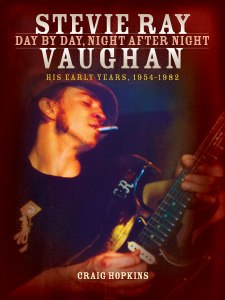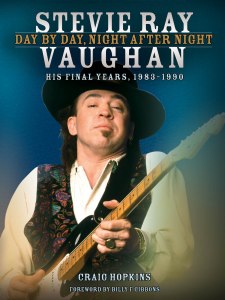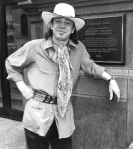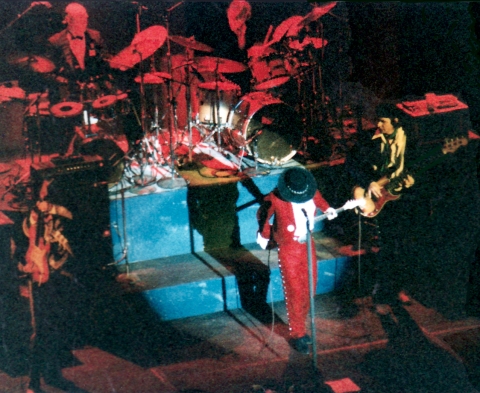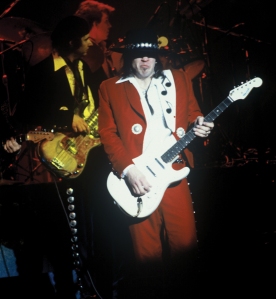Blog Archives
Happy Birthday, Stevie Ray Vaughan!
From the first of two volumes, Stevie Ray Vaughan – Day by Day, Night after Night: The Early Years, by Craig Hopkins: a series of early first impressions and fond memories for Stevie’s birthday today.
Musician and guitar dealer, TONY DUKES: “It was a warm day, the first time I saw Stevie Ray. All you could see was stringy brown locks and a toothy grin over the top of a red Gibson 335 [possibly an Epiphone]. What made you look was the tone, a guitar tone that seems to scream and breathe…One thing that always struck me odd, but identifiable, in my eyes about Stevie – his resilience and his quiet confidence.”
RODDY COLONNA, drummer: “I first met Stevie in the school lunchroom at Kimball High School. He was kind of weird looking to me, a little bit, because he wore these big sunglasses and bell bottoms with this little sash thing, paisley shirt, and he wore a dickey too – ascot-type thing. One day he came up and sat by me in the lunchroom and started talking to me like he knew me. He was talking about his band. I had a car, and that made it good for him because he didn’t have any wheels. He was just a kid; real friendly.”
Blackbird keyboard player NOEL DEIS: “Christian [Plicque] brought Stevie over and I thought, ‘This kid sounds like Eric Clapton!” He was a little bit tentative, but he had a darn good sound. He had no equipment. I can’t remember what he dragged over, but it wasn’t much. Stevie went to Kimball and was the outcast kid that was picked on by the local jock population.
CHRIS LAYTON: “The first time I heard [Stevie] play was [with the Cobras] on a Tuesday night at a place called Soap Creek Saloon in Austin. It was either late ’76 or real early ’77. When I walked in, they were already playing. Immediately, Stevie caught my ear because of his energy and this feeling from his playing. They were doing Bobby Bland stuff, a couple James Brown things, and a song by Ronnie Laws called ‘Always There.’
I walked in and turned the corner where you could see the band, and Stevie was playing a solo, and I was, like, mesmerized…he had so much presence, and, I don’t know, this undefined energy and charisma.”
BRUCE BOWLAND: “Even offstage, rarely did I see Stevie without his guitar slung over his shoulder. He was one of those guys who just walked around the house and piked. He’d sit there and talk to you and he’d be picking. About the only time he’d take it off is when he’d go to the bathroom. He had a burning desire, not to be famous, but to be as good as he possibly could be.”
Stevie Ray Vaughan – Day By Day, Night After Night
 It is no easy feat to capture the enormous spirit of Stevie Ray Vaughan, a man whose presence in the world was like an untamable fire, shooting flames of raw talent, passion, and innovation. That bright light wrestled with a dark side, an addiction and sadness that threatened to put out the fire forever. His unmatched guitar playing, buttery vocals, and unforgettable songs made him a triple threat. Vaughan is arguably the greatest guitar god who has ever lived – a re-inventor of guitar and the blues. Twenty years after his death, he lives on in the hearts of millions of people around the world.
It is no easy feat to capture the enormous spirit of Stevie Ray Vaughan, a man whose presence in the world was like an untamable fire, shooting flames of raw talent, passion, and innovation. That bright light wrestled with a dark side, an addiction and sadness that threatened to put out the fire forever. His unmatched guitar playing, buttery vocals, and unforgettable songs made him a triple threat. Vaughan is arguably the greatest guitar god who has ever lived – a re-inventor of guitar and the blues. Twenty years after his death, he lives on in the hearts of millions of people around the world.
In a day-by-day format, Craig Hopkins presents an unprecedented celebration of this wonderful artist. This book is the first installment of a two-volume account of Vaughan’s life. With this work, Hopkins delivers one of the most detailed biographies of any musician. This edition covers the complete history of Vaughan’s roots, from his childhood to just before his first major release. Filled with testimonials from those who knew him best and from fans everywhere, along with facts about tour dates and recordings, stories about his bands and life on the road, rare artistic and historic photographs, and more, this lavishly illustrated book is the ultimate collector’s item for any Stevie Ray Vaughan fan.
Stevie Ray Vaughan: 27 Years Since Carnegie Hall

Stevie Ray Vaughan--Day by Day, Night After Night: His Final Years, 1983-1990
The following is an excerpt from Stevie Ray Vaughan–Day by Day, Night After Night by Craig Hopkins. This book is available as separate volumes: His Early Years, 1954-1982 and His Final Years, 1983-1990, as well as together in a deluxe boxed set.
October 4, 1984
Chesley [Millikin, Stevie’s manager] said Stevie wanted to play Carnegie Hall, and he sold it to Ron Densler in New York as a blues show – the only time Chesley ever presented Stevie as a bluesman.
The band wore custom velvet “mariachi” suits made for the show, Stevie in red for part of the show and then in a blue suit matching those of Double Trouble. The band built a stage set of blue and gold and wanted to film the show, but CBS Records decided against it and only recorded the audio. Chris [Layton] recalls why the band went to the trouble of costumes and stage set: “Because it was Carnegie Hall – historical place – and so many great people have been there. It seemed like a real privilege to be able to go there and do that. We thought, ‘God, it’s so special, let’s make it more special than just haulin’ the gear in there and setting up and just playing.’”
There was a 4:00 p.m. sound check, which was the only practice in Carnegie Hall before the show.
Stevie was introduced as “one of the greatest guitar players of all time” by John Hammond, whose loyal support after hearing the Montreux tape included serving as Executive producer of both Texas Flood and Couldn’t Stand the Weather.
The show was benefit for the T.J. Martell Foundation’s work in leukemia and cancer research. The 2,200 seats were all sold. Stevie was extremely excited and nervous, saying he didn’t calm down until about halfway through the third song.
STEVIE: “We had a limousine to take us to [Carnegie Hall], which is half a block from here, but it was necessary. Every time we’d go down there or come back to the hotel, we had to get in this car and do a couple of blocks so I didn’t have to stand there with a lot of people that I didn’t know, and some that I did, getting mad at me because I couldn’t get them tickets of backstage passes. The last time I was that nervous is when I got married, but I couldn’t show that to anybody. There were some panicky times in rehearsal, but I can’t show them how freaked out I am. I’m supposed to be leading this thing. Are you gonna follow somebody who is shaking in their shoes? It’s a fear of not living up to what you’re trying to do. I’m not sure how to say this. Sometimes something can almost mean too much, you know? I sounded as nervous as I was. I calmed down about halfway through ‘Voodoo Chile.’ I looked over at Tommy, and he was just sort of staring at me, and that’s when I knew it was gonna be all right.”
After the show, MTV threw a private part for the band, record company and other VIPs. It took [Stevie] an hour just to walk from the bar to the table across the room where his parents were sitting. Stevie Ray found his father, a retired asbestos worker who hadn’t taken a plane ride since the Korean War, and hugged him until they both cried.
On Oct. 6, Joe Rhodes wrote in the Dallas Times Herald, “Tomorrow there will be chamber music here again, string concertos and people in tuxedos politely applauding the works of Bartok and Bach. But Thursday night, this place was full of stomping feet and swaying bodies, kids in blue jeans hanging off the balconies, dancing bodies that clogged the aisles. Thursday night, it belonged to Stevie Ray Vaughan.”
